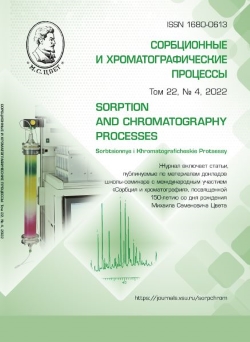Interaction of glycine with a hydrogel based on a copolymer of acrylamide and sodium acrylate
Abstract
To assess the possibility of absorption of amino acids by superabsorbents and the effect of the temperature of the sorption on the degree of absorption, we studied the interaction of glycine with a hydrogel based on a copolymer of acrylamide and sodium acrylate at 296 and 280 К in aqueous solutions with the concentration range of 0.005-0.1 mol/dm3.
The study determined that the amount of absorbed glycine is smaller at 280 K than at 296 K. The dependences of the distribution coefficient on the equilibrium concentrations of glycine pass through maximums. The growth of the distribution coefficient is explained by the accumulation of the amino acid in the sorbent phase at low concentrations of the solution. The sorption centres are then filled and the internal solution is structured, which results in a decrease in the distribution coefficient.
The amino acid is present in the aqueous solution in the form of a bipolar ion. This prevents the recharging of the system “functional group - counterion”. Therefore, the absorption proceeds according to the non-exchange sorption mechanism. Assuming that the sorption centre in the system is COOK, i.e. A group incapable of exchange under the said conditions, the thermodynamic description was based on the idea of a stoichiometric character of the process.
We calculated the activity coefficients, thermodynamic constants, and Gibbs differential energies, which were negative, which indicates that the processes are spontaneous and energetically favourable. We should note that this value varied from -13 to -5 kJ/mol in all the systems during the sorption of the studied amino acid. This indicates the weak interaction of the absorbed amino acid with the hydrogel phase.
Using the Gaussian 09W software by the DFT method at the B3LYP/6-31G (d, p) level we performed computer modelling of the hydrogel swelling with the number of molecules of water in the functional group varying from 9 to 15. Quantum-chemical modelling demonstrated that absorption of glycine by hydrogel is accompanied by redistribution of molecules of water between the amino acid and the functional groups of the hydrogel.
Downloads
References
Xinyue Liu, Ji Liu, Shaoting Lin, Xuanhe Zhao. Hydrogel machines. Materials Today. 2020; 36: 102-124. https://
doi.org/10.1016/j.mattod.2019.12.026
Arn Mignona, Nele De Beliea, Peter Dubruel, Sandra Van Vlierbergheb. Super-absorbent polymers: A review on the characteristics and applications of synthetic, polysaccharide-based, semi-synthetic and ‘smart’ derivatives. European Polymer J. 2019; 117: 165-178. https://doi.org/10.1016/j.eurpolymj.2019.04.054
Faheem Ullah, Muhammad Bisyrul Hafi Othman, Fatima Javed, Zulkifli Ahmad, Hazizan Md. Akil. Classification, processing and application of hydrogels: A review. Mate-rials Science and Engineering C. 2015; 57: 414-433. https://doi.org/10.1016/j.msec.2015.07.053
Sennakesavan G., Mostakhdemin M., Dkhar L.K., Seyfoddin A., Fatihhi S.J. Acrylic acid/acrylamide based hydrogels and its properties – A review. Polymer Degradation and Stability. 2020; 180: 1-11. https://doi.org/10.1016/j.polymdegradstab.2020.109308
Minmin Li, Yuting Xiong, Guang-yan Qing. Smart bioseparation materials. TrAC Trends in Analytical Chemistry. 2020; 124: 1-12. https://doi.org/10.1016/j.trac.2019.06.035
Kurenkov V.F., Vodorastvorimye polimery akrilamida, Sorovsky educational J. 1998; 11: 138-142.
Khokhlov V.Yu. Dis. d-ra khim. nauk. Voronezh. 2008. 315 p.
Roshal E.R., Demina N.G., Sholin A.F. Analysis of amino acids in the form of copper complexes. Russian Chem.-Pharm. J. 1988; 6: 30-37. (In Russ.)
Trunaeva E.S., Khokhlova O.N., Khokhlov V.Y. Thermodynamic description of the nonexchange sorption of sub-stances by ion exchangers. Russian J. of Physical Chemistry A. 2018; 92(12): 2440-2444. https://doi.org/10.1134/S0044453718120440
Frisch M.J., Trucks G.W., Schlegel H.B., Scuseria G.E., Robb M.A., Cheeseman J.R., Scalmani G., Barone V., Petersson G.A., Nakatsuji H., Li X., Carica-to M., Marenich A., Bloino J., Janesko B.G., Gomperts R., Mennucci B., Hratchian H.P., Ortiz J.V., Izmay-lov A.F., Sonnen-berg J.L., Williams-Young D., Ding F., Lipparini F., Egidi F., Goings J., Peng B., Petrone A., Henderson T., Ranasinghe D., Zakrzewski V.G., Gao J., Rega N., Zheng G., Liang W., Hada M., Ehara M., Toyota K., Fukuda R., Hasegawa J., Ishida M., Nakajima T., Honda Y., Kitao O., Nakai H., Vreven T., Throssell K., Montgomery J.A., Jr., Peralta J.E., Ogliaro F., Bearpark M., Heyd J.J., Brothers E., Kudin K.N., Staroverov V.N., Keith T., Kobayashi R., Normand J., Raghavachari K., Rendell A., Burant J.C., Iyengar S S., Tomasi J., Cossi M., Millam J. M., Klene M., Adamo C., Cammi R., Ochterski J.W., Martin R.L., Morokuma K., Farkas O., Foresman J.B., Fox D.J. Gaussian 09, Revision A. 02. Gaussian, Inc., Wallingford CT, 2016.
Makogon B.P., Bondarenok T.A. Gidratatsiya polietilenoksida i poliakrilamida v rastvore. Vysokomolekulyarnye soedineniya. 1985; 27(3): 563-566. (In Russ.)
Masimov E.A., Abbasov Kh.F. Hy-dration numbers of ions in aqueous solu-tions of KOH, KCl, KI, and KIO3 according to refractometric data. J. of physical chemistry. 2013; 87(8): 1438-1440. https://doi.org/10.7868/S0044453713080190







